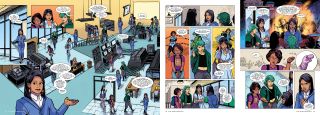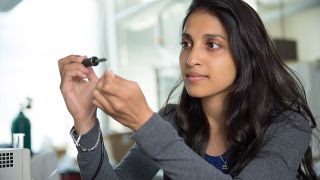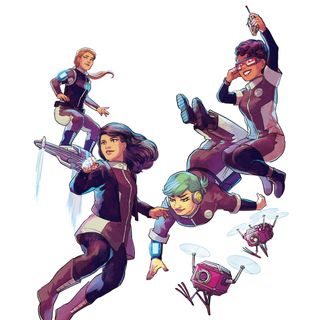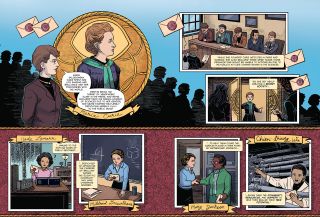Take into consideration a secret group that mixes the distinctive abilities and bodily talents of its brokers with unimaginable gadgets to protect the world from evil villains bent on using science to rule the world.
No, we’re not talking regarding the subsequent instalment of James Bond, nevertheless the unimaginable female scientists throughout the “Curie Society” assortment of YA graphic novels.
Following the exploits of candy sixteen science prodigies Simone, Maya and Taj, the two books throughout the assortment are action-packed adventures the place the first protagonists study to make use of their presents to change into the next secret brokers in The Curie Society — a secret group long-established to assist distinctive female scientists world large (and put it apart on the similar time).
Ahead of the second book’s launch, we spoke to MIT professor Ritu Raman, one in every of many lead science advisors on the gathering, about how graphic novels would possibly assist promote STEM coaching, why selection is so mandatory and what it’s want to be immortalized in comic book type.
Alexander McNamara: How did you get entangled throughout the making of the Curie Society books?
Ritu Raman: I met Heather and Adam [Einhorn and Staffaroni, authors of the books] quite a few years previously as soon as I used to be postdoc at MIT, and we had been talking about how there’s a lack of content material materials for preteen and teenage girls that displays science in every an thrilling method, however as well as an right method. One factor that motivates of us, nevertheless then moreover displays them, inside motive, what’s going on on on this planet of STEM instantly.
When Heather and Adam did the first book, they talked to a bunch of assorted scientists and engineers from numerous completely totally different views. There was an unlimited collaborative effort to put the first story collectively, which I imagine was notably mandatory after they’re fleshing out the three main characters and their origin story.
AM: What was your operate throughout the assortment and the best way did you help in its creation?
RR: It modified between books. Inside the first, they talked to numerous completely totally different scientists who do completely totally different styles of labor and had completely totally different paths to science. I imagine that was really mandatory for them to take bits and gadgets of people’s real experiences and weave them into the characters.
Part of my story is shifting spherical fairly a bit rising up, and consequently I skipped numerous grades bouncing between completely totally different schools. And so of the three characters, Simone’s experience of being youthful and by no means primarily emotionally matched in maturity to the place that she is, whereas being matched scientifically, comes from me.
Then throughout the context of Maya, who is supposed to be South Asian or Indian, the cultural exploration of science and totally different points, I imagine come a bit bit from myself. The third character [Taj], is polar reverse from me, nevertheless really, strikes a chord in my memory of thought of one in every of my shut buddies.

Inside the first book I shared my experience and provided ideas on a bit little little bit of the science, nevertheless really we talked further about depictions of bioethics and the best way scientists do or don’t think about the implications of their work. Who have to be throughout the room when these alternatives are being made? How can we portray a villain who begins off sort of as an excellent scientist and presumably points go unsuitable? I was providing ideas further at that diploma.
Inside the second book, they decided to pursue a method of getting one main scientist to work with, and so I acquired to see the story and help craft it from very early visions. I did rather more accuracy checking, however as well as if we needed a experience that may, say, paralyze any individual nevertheless not hurt them ceaselessly, I was brainstorming the completely totally different devices and utilized sciences which will very nicely be highlighted.
We moreover decided to do an prolonged operate of the work that we do in our lab. Usually, whereas you must make one factor great cool and thrilling to study, you might be depicting utilized sciences 5 or 10 years from now, correct? So we moreover wished to offer folks one factor that’s occurring in labs correct now, and that people could possibly be like, “Wow, I might have thought that that didn’t exist however.”
We wished to level out myself, along with the women working with me in my lab and the kinds of points that they do. It was really cool to have the flexibility to highlight some precise school college students at MIT throughout the context of the Curie Society.
Study further interviews on Reside Science
AM: How does it actually really feel to be immortalized in comic book type?
RR: I’m residing throughout the dream, really. I’ve on a regular basis wished to jot down and contribute to the world of fiction, nevertheless as soon as I write for work, I’m a scientist, I write a extremely explicit plan of one of the best ways to get a grant funded throughout the subsequent 5 years which will do exactly this and this. There’s creativity in there, however it absolutely’s creativity inside very strict constraints, and I imagine the prospect to launch these constraints a bit bit and nonetheless scratch that creative part of my thoughts, whereas talking regarding the science…. It is rather cool, I’m very fully glad about it.
AM: That creative course of is pretty mandatory, and clearly the book is stuffed with science. As a result of the advisor to the story, how far can you push the science from actuality to fiction?
RR: That’s an attention-grabbing question, notably on account of there are most likely completely totally different parts of science that I take care of another way in that method. I indicate one in every of many points about being a PhD expert scientist and dealing in a lab is that I discover out about some very space of curiosity areas, nevertheless then I actually have a stage in mechanical and aerospace engineering. However it absolutely’s not like I can really comment too deeply on among the many work on airfoil design for planes, which confirmed up in one in every of many books.
I sometimes actually really feel like I’m hypercritical of the problems that are nearer to my work related to genetic engineering or making new tissues by 3D printing — that sort of stuff that I do know fairly a bit about. So the very very first thing I do is try and modulate. For points that are not immediately in my house of expertise, I imagine I’ll give rather more freedom — if this passes the odor check out or it will not defy or primarily break the authorized tips of physics, it’s good. Presumably it is not exactly fully correct, however it absolutely’s a story and that’s OK. With stuff that is further related to the problems that I do, I’ve to first try and censor myself a bit bit further.

So I try and first flip off that part of my thoughts, nevertheless I imagine now that now we have labored collectively for just a few years the group hopefully feels cosy being like, “Hey, that’s the rationale we wished to say it that method. In case you actually really feel that’s primarily unsuitable, is there one factor else let’s imagine that may nonetheless switch the story from stage A to stage B?”
I imagine notably worrying in an earlier draft is good, on account of then sooner than they’ve devoted an extreme quantity of to 1 factor, I can work out one of the best ways to biggest lead science into that. I imagine merely having an excellent relationship with the authors over just a few years has helped.
AM: It ought to have been pleasurable really with the flexibility to find totally different areas of science that you just’re not an skilled in. Did you examine fairly a bit from researching the story as properly?
RR: Yeah, I indicate, I’m not incentivized in my job to suppose exterior of the exact context of what my lab works on on account of I’m paid to be an skilled. Zooming once more out and being a generalist sparks your private enthusiasm for the problems that you just thought had been cool when you had been a baby. I really wished to enter aerospace and make rockets, and I nonetheless suppose these points are thrilling, however it absolutely’s not what I’m doing correct now.
You presumably cannot do all of the issues, nevertheless I imagine that among the many utilized sciences, particularly related to vitality and the native climate catastrophe, are very thrilling. Even supposing numerous my work is focused on human nicely being — which is good and actually motivating — sometimes, as a human being residing on the planet, you might be moreover pondering further broadly about totally different grand challenges that are going by us. So catching up on what all people else is doing could possibly be very heartening and thrilling to see.
AM: How environment friendly do you suppose graphic novels are in getting of us into STEM.
RR: Certainly one of many points that I imagine is important is make sure we’re meeting of us the place they’re. Some of us reply fairly nicely to the written phrase, some of us reply properly to digital media, some of us would really like all of the issues to be delivered to them inside the kind of a dance — and that’s OK. Usually most people are a mix of those points and it is important to listen to stuff repeated three or 4 completely totally different events for it to truly sink in.
I imagine graphic novels slot in a pleasing space. We now have TV displays the place of us describe science for youngsters of assorted audiences, and there’s numerous YouTube films that do that. Science fiction novels moreover do a job of exploring that space, nevertheless they sometimes seem to deal with older audiences and truly take care of dystopian visions of the long term.

So when you’re keen about this viewers, how do you introduce sensible science fiction in a visually compelling method, that has a narrative and likewise highlights quite a few completely totally different varieties of people? You can presumably positively do it by way of superhero movies, nevertheless [graphic novels] are one different method of doing it that I imagine could really attain a ton of people, and will probably be one factor they revisit over time. Presumably it’s of their bookshelf and they also check out it nevertheless can’t understand it the first time; then they go and they also examine one factor at school and to allow them to come once more and go to that net web page.
I imagine it’s one part of the arsenal, which doesn’t have a ton of points in it correct now, nevertheless there’s a large different for us to attain tons of people that would not in another case see these kinds of tales.
AM: The book itself has a extremely quite a few stable of characters and is clearly focused on getting further girls into STEM. Out of your perspective, is science doing ample to make this optimistic change, and what further could we be doing?
RR: I imagine as long as society is evolving we’re on a regular basis participating in catch up in any self-discipline to ensure that we’re capturing whatever the current distribution of the inhabitants is. I imagine in science, as an example, now we have now made nice progress in recruiting further girls into undergraduate packages — positively at MIT now we have had 50% girls in our undergraduate packages for just a few years, which is gorgeous — nevertheless as you go farther alongside, positively in graduate school, throughout the professoriate, throughout the administration of STEM corporations, the illustration, on the very least of girls and positively individuals who match completely totally different parts of selection, it’s nonetheless very low.
Certainly one of many points I really like about one of the best ways the Curie Society constructions its characters is that although the protagonists are youthful, there are many older female scientists that are portrayed as really senior of us throughout the books. I imagine that’s important on account of they lovely overtly acknowledge that the world they confronted was fairly completely totally different to what these youthful girls are going by, and that interplay has been very good to see. I’ve by no means really seen that in several media or totally different tales.
I do suppose that no matter inroads in getting further of us obsessed with science, as soon as I work along with heart schoolers, and teenage girls particularly, there’s nonetheless numerous hesitation and an absence of self-belief regarding the operate that they are going to play in science. I don’t suppose it’s one factor that we’ll pat ourselves on the once more and say, “This generally is a solved downside, we needn’t worry about this anymore.” We’re combating 1000’s of years of all of us having positive beliefs about who’s in a position to what, so I imagine we nonetheless have some work to do there, on the very least to take care of the pipeline going.
Nevertheless we even need to acknowledge that merely getting a bunch of 12-year-olds obsessed with science is not ample. It is important to actually shield and promote and retain that enthusiasm all by their lives, and that may be a for for much longer scale downside.
AM: Do you suppose there are any express challenges to getting youthful of us, notably youthful girls, into science? Is there one thing we’ll do?
RR: One menace that I see correct now’s that it’s nice to deal with girls and youthful girls that are obsessed with science, however when these are the one of us throughout the story, you might be sort of eradicating them from a pure context or the reality that we dwell in a extremely gender-diverse society. I might wish to see further male characters interacting with these female scientists in respectful strategies.
I imagine now we have to be very cautious of not merely telling youthful girls to pursue science, however as well as educating youthful males that, “Are you aware that there are girls who do science and are very good at it and we’ll all play collectively and do cool points?”
Further broadly, guaranteeing our interventions are normally not merely targeted at people who decide as girls is the missing gap throughout the self-discipline that we’ll maintain pushing in the direction of.

AM: So principally what now we have to do is see further individuals who discover themselves throughout the science setting in entrance of people talking about what we’re doing?
RR: Yeah, and get further youthful boys to study these books too. I merely think about the number of books I study as a baby that featured youthful boys and I nonetheless realized fairly a bit from them. I might love for it to go the alternative method. Certain the story is about girls and I hope youthful girls choose it, nevertheless I hope numerous boys study it too and suppose that it’s an thrilling story and one factor to emulate.
AM: Lastly, for many who had been a character throughout the book, what would your specialised potential be? In case you are already a member of the Curie Society and are holding it secret, that’s great…
RR: Certainly one of many points I on a regular basis need I could do — notably on account of we in my lab are on a regular basis setting up little tissues and fashions of the human physique after which attempting to know what happens contained within the human physique — is with the flexibility to go inside a person and see exactly what’s going on unsuitable. I imagine most likely with the flexibility to see, at very extreme determination, how cells are talking to 1 one other and the best way we’ll manipulate that, that may most likely be the important thing potential — nevertheless you’ll under no circumstances know, I’ll under no circumstances inform.
